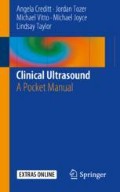Abstract
Learning ultrasound can be overwhelming and confusing, especially for those who are becoming familiar with equipment and images for the first time. This chapter will provide an overview of basic point-of-care ultrasound physics and procedure. It will explain ultrasound-specific terminology for image optimization, transducer types including clinical application and positioning, and different scanning modes such as brightness mode, motion mode, and Doppler. Lastly, common ultrasound artifacts, their characteristics, and how to recognize them will be described.
Access this chapter
Tax calculation will be finalised at checkout
Purchases are for personal use only
References
Hecht C, Manson W. Chapter 3: physics and image artifacts. In: Ma OJ, Mateer JR, Reardon RF, Joing SA, editors. Emergency ultrasound. 3rd ed. China: McGraw-Hill Education; 2014. p. 33–46.
Scruggs W, Fox JC. Chapter 2: equipment. In: Ma OJ, Mateer JR, Reardon RF, Joing SA, editors. Emergency ultrasound. 3rd ed. China: McGraw-Hill Education; 2014. p. 15–32.
Saul T, Del Rios Rivera M, Lewiss R. Focus on: ultrasound image quality. ACEP News website. 2011. https://www.acep.org/Content.aspx?id=79787. Accessed 17 April 2017.
Rasalingham R, Makan M, Perez JE. The Washington manual of echocardiography. Saint Louis, MO: Department of Medicine, Washington University School of Medicine, Lippincott Williams & Wilkins; 2013.
Author information
Authors and Affiliations
Corresponding author
Electronic Supplementary Material
B-mode imaging: Brightness mode (B-mode) imaging is the standard modality of obtaining ultrasound images. It is represented by the conversion of ultrasound waves into grayscale imaging. In this image, the heart is visualized by obtaining a parasternal long view (MP4 2386 kb)
Color Doppler: Color Doppler represents shifts in velocity that are color coded—flow away from the transducer will appear blue, and flow toward the transducer will appear red. Here color Doppler of the testicle is being examined (MP4 272 kb)
Power Doppler: Power Doppler has a higher sensitivity than color Doppler for detecting flow. Under power Doppler, a color signal will be displayed if there is any motion detected. In this image, the testicle is being examined using power Doppler (MP4 2011 kb)
Bone shadowing: Posterior acoustic shadowing occurs when ultrasound waves cannot penetrate a substance such as bone or calcified tissues. When ultrasounding the lungs, each rib will demonstrate posterior acoustic shadowing artifact as demonstrated in this image (MP4 255 kb)
Gallstone shadowing: Gallstones will exhibit posterior acoustic shadowing artifact which also helps identify and confirm the structure images as a stone rather than a gallbladder polyp, for example (MP4 2135 kb)
Gallbladder with PAE: Posterior acoustic enhancement occurs when sound passes through a fluid-filled structure, such as a gallbladder (imaged here), resulting in structures more posterior to become brighter or more echogenic (MP4 1872 kb)
Lung with reverberation artifact: Reverberation artifact occurs when sound bounces between two greatly reflective structures. For example, when ultrasounding the lungs, sound waves will hit the pleural line and cause reverberation artifact, seen as multiple horizontal lines throughout the lung architecture (MP4 2220 kb)
Liver with mirror artifact: When ultrasound waves hit a highly reflective structure, such as the diaphragm, the machine will interpret the images as coming back twice resulting in mirror artifact (MP4 1594 kb)
Gallbladder with edge artifact: When ultrasound waves are refracted by a reflective, rounded structure, the beam will not return to the transducer, resulting in edge artifact. This is seen as shadowing behind the edge of a rounded structure such as the gallbladder (MP4 1930 kb)
Rights and permissions
Copyright information
© 2018 Springer International Publishing AG
About this chapter
Cite this chapter
Vitto, M., Creditt, A.B. (2018). Introduction: Basic Ultrasound Principles. In: Clinical Ultrasound. Springer, Cham. https://doi.org/10.1007/978-3-319-68634-9_1
Download citation
DOI: https://doi.org/10.1007/978-3-319-68634-9_1
Publisher Name: Springer, Cham
Print ISBN: 978-3-319-68633-2
Online ISBN: 978-3-319-68634-9
eBook Packages: MedicineMedicine (R0)

